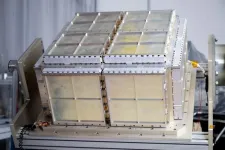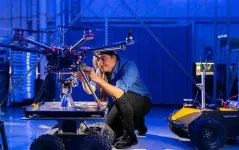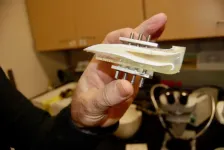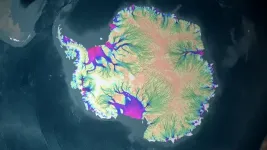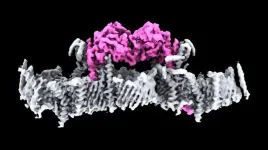(Press-News.org) WASHINGTON, D.C. — The U.S. Naval Research Laboratory (NRL), in partnership with NASA’s Marshall Space Flight Center (MSFC), has developed StarBurst, a small satellite (SmallSat) instrument for NASA's StarBurst Multimessenger Pioneer mission, which will detect the emission of short gamma-ray bursts (GRBs), a key electromagnetic (EM) signature that will contribute to the understanding of neutron star (NS) mergers.
NRL transferred the instrument to NASA on March 4 for the next phase, environmental testing. From there, the instrument will be integrated onto the spacecraft bus, followed by launch into Low Earth Orbit in 2027. StarBurst will be installed as a secondary payload via the Evolved Expendable Launch Vehicle Secondary Payload Adapter Grande interface with a mission duration of one year, with the option of extension.
"StarBurst represents a significant leap forward in gamma-ray astronomy," said Richard S. Woolf, Ph.D., research physicist with NRL’s Space Science Division. "Our team at NRL has drawn upon years of expertise in detector development to create an instrument that is both highly sensitive and cost-effective. StarBurst will play a critical role in the exciting new era of multimessenger astronomy, allowing us to study neutron star mergers in unprecedented detail."
NS collisions are significant cosmic events and are recently understood as major producers of heavy elements such as gold and uranium. This process, known as nucleosynthesis, involves the formation of new atomic nuclei and occurs in various astrophysical settings, including neutron star mergers, supernovae, stellar burning, and the Big Bang.
The StarBurst Multimessenger Pioneer is a wide-field gamma-ray observatory focused on detecting short-duration bursts of gamma-rays that are produced following NS mergers that are observed via the gravitational waves that they produce. The combination of the gamma-ray and gravitational-wave signals provides fundamental insight into the parent stars and the physics of these extreme explosions. With an effective area four times greater than the Fermi Gamma-ray Burst Monitor – the most sensitive monitor currently on orbit – it will provide full coverage of the unobscured sky. The enhanced sensitivity due to the large collecting area of the telescope will make StarBurst a vital partner to the gravitational wave network. This will significantly increase the detection rate of EM counterparts to NS mergers at a fraction of the cost of current gamma-ray missions.
The fundamental properties of the gamma-ray bursts measured by StarBurst will give scientists a representative picture of the ensemble properties of remnant explosions following NS mergers, for the first time.
The StarBurst Sensor Head comprised of 12 thallium-doped cesium iodide (CsI:Tl) scintillation detectors, each utilizing a custom array of low-mass, low-voltage silicon photomultipliers (SiPMs), is designed to allow StarBurst to detect GRBs in an energy range from 50 keV to 2000 keV, optimizing its sensitivity.
The instrument's design is inspired by NRL's successful technology demonstrator, Glowbug, led by J. Eric Grove, Ph.D., NRL Space Science Division Acting Superintendent, which recently concluded a highly productive mission on the International Space Station, detecting numerous GRBs and contributing to important astrophysical research.
StarBurst is a collaborative effort. MSFC leads the mission and partners with NRL, the University of Alabama Huntsville, the Universities Space Research Association, and the University of Toronto Institute for Aerospace Studies Space Flight Laboratory.
NRL's contributions to StarBurst build upon the success of Glowbug, demonstrating the laboratory's commitment to advancing space-based scientific research. The StarBurst mission promises to unlock new insights into the universe's most energetic events and to further solidify NRL's leadership in cutting-edge space technology.
About the U.S. Naval Research Laboratory
NRL is a scientific and engineering command dedicated to research that drives innovative advances for the U.S. Navy and Marine Corps from the seafloor to space and in the information domain. NRL is located in Washington, D.C. with major field sites in Stennis Space Center, Mississippi; Key West, Florida; Monterey, California, and employs approximately 3,000 civilian scientists, engineers and support personnel.
For more information, contact NRL Corporate Communications at (202) 480-3746 or nrlpao@nrl.navy.mil. Please reference package number at top of press release.
###
END
WINSTON-SALEM, N.C. – March 13, 2025 – A study from researchers at Wake Forest University School of Medicine highlights a new approach in addressing conductive hearing loss. A team of scientists, led by Mohammad J. Moghimi, Ph.D., assistant professor of biomedical engineering, designed a new type of hearing aid that not only improves hearing but also offers a safe, non-invasive alternative to implantable devices and corrective surgeries.
The study recently published in Communications Engineering, a Nature Portfolio journal.
Conductive ...
Envision a world where unmanned aircraft deliver goods to your front door and transport passengers in flying taxis, cargo planes cross continents carrying vital trade goods, and fighter jets patrol battle zones—all without a human pilot at the controls.
Those scenarios might seem a bit far-fetched now, but researchers are working diligently to develop these aircraft and ensure they operate safely. That’s why NASA has awarded a $1 million grant through its University Leadership Initiative (ULI) to a team from The University of Texas at Arlington Research ...
You may scarcely notice it, but much of what you do every day requires your brain to engage in perceptual learning. To safely cross an intersection or quickly retrieve something from your bag, you depend upon your brain to first assign meaning to sensory input from your eyes or fingertips.
Usually, it’s effortless.
Research from The Herbert Wertheim UF Scripps Institute for Biomedical Innovation & Technology shows a gene called Syngap1 enables touch-based perception, while certain mutations can lead to mixed signals. The research was made possible through grants from the National Institute of Mental Health and the National Institute ...
Teeth recovered from a beloved zoo elephant that died in 2008 are helping University of Utah geologists develop a method for tracking the movements of large herbivores across landscapes, even for animals now extinct, such as mastodons and mammoths.
Outlined in recently published findings, the technique analyzes isotope ratios of the element strontium (Sr), which accumulates in tooth enamel. For large plant-eating land mammals, the relative abundance of two strontium isotopes in teeth and tusks ...
For cancers of organs like the liver, the long-term impact of our diet has been well studied — so much so that we have guidance about red meat, wine and other delicacies.
A new study from researchers at University of Florida Health looks at another kind of organ whose cancer risk may be affected by poor diet: the lungs. The study was funded by several National Institutes of Health grants and a collaboration between the University of Kentucky's Markey Cancer Center and the UF Health Cancer Center.
“Lung ...
The early mammals that lived alongside the dinosaurs upwards of 150 million years ago (mya) were likely covered in dark and dusky greyish-brown fur, according to a quantitative reconstruction of Mesozoic mammal coloration, hinting at their shrouded and nocturnal nature. The findings, drawn from a comparative analysis of fossilized melanosomes, provide insights into the ecology and evolutionary history of early mammals. From communication to camouflage, animal coloration plays an important role in numerous behavioral ecological ...
The deliberate destruction of the Kakhovka Dam in Ukraine during the Russo-Ukrainian war unleashed a hidden environmental crisis, destroying ecosystems and releasing polluted sediments into downstream water systems, according to a new study. The findings provide critical new insights into the prolonged ecological risks of strategic dam destruction during warfare and the effects that may persist for years beyond war. “Our work highlights the far-reaching environmental consequences of the [Kakhovka Dam] destruction and raises concerns not only about the use of water as a weapon, but also about ...
The U.S. National Institutes of Health’s recent decision to impose a 15% cap on facilities and administrative (F&A) cost reimbursements threatens to undermine the quality and sustainability of university research by slashing indirect funding by $4 billion. In a Policy Forum, Jeongwon Choi and colleagues argue that this policy is fundamentally flawed, as it disregards the essential role of indirect costs, such as infrastructure, utilities, and administrative support, in enabling scientific research. The current system, governed by rigorous federal oversight and audits, ensures that F&A reimbursements are fair and necessary, varying across institutions based on actual costs. NIH’s ...
As the planet warms, Antarctica’s ice sheet is melting and contributing to sea-level rise around the globe. Antarctica holds enough frozen water to raise global sea levels by 190 feet, so precisely predicting how it will move and melt now and in the future is vital for protecting coastal areas. But most climate models struggle to accurately simulate the movement of Antarctic ice due to sparse data and the complexity of interactions between the ocean, atmosphere, and frozen surface.
In a paper published March 13 in Science, researchers at Stanford University used machine learning to analyze high-resolution ...
WEHI researchers have made a huge leap forward in the fight against Parkinson’s disease, solving a decades-long mystery that paves the way for development of new drugs to treat the condition.
First discovered over 20 years ago, PINK1 is a protein directly linked to Parkinson’s disease – the fastest growing neurodegenerative condition in the world. Until now, no one had seen what human PINK1 looks like, how PINK1 attaches to the surface of damaged mitochondria, or how it is switched on.
In ...
